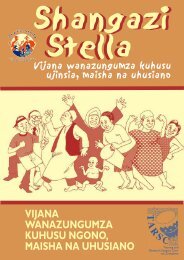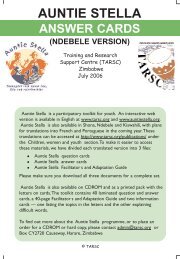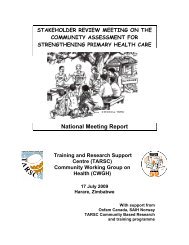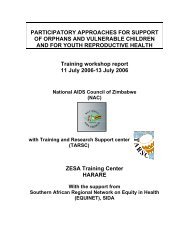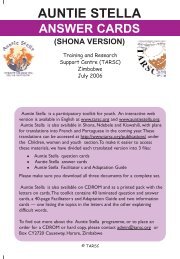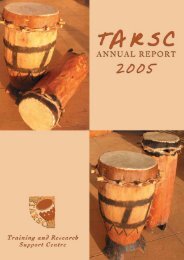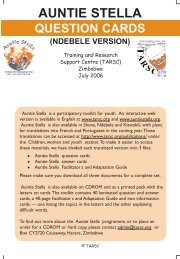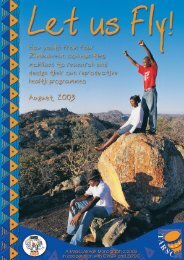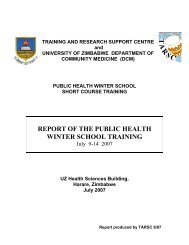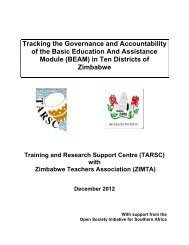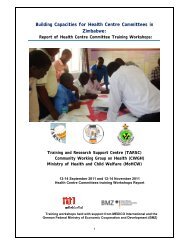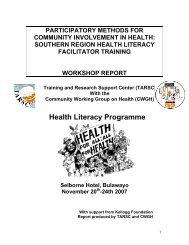WS10 Report.pdf - Training and Research Support Centre
WS10 Report.pdf - Training and Research Support Centre
WS10 Report.pdf - Training and Research Support Centre
You also want an ePaper? Increase the reach of your titles
YUMPU automatically turns print PDFs into web optimized ePapers that Google loves.
She then covered the effects of traditional medicine on the management of health <strong>and</strong><br />
disease <strong>and</strong> its integration with conventional health systems. Mrs Monera also covered<br />
Zimbabwe Law on traditional medicine, traditional doctors training <strong>and</strong> distribution,<br />
research <strong>and</strong> the value of traditional medicine to health <strong>and</strong> disease control. Finally, she<br />
noted the current trends, issues <strong>and</strong> obstacles in traditional medicine <strong>and</strong> practice <strong>and</strong><br />
suggestions on how these could be addressed.<br />
2.8 Mentored assignment one : On Public health<br />
This exercise aimed to use the teaching on public health to test how participants, as public<br />
health practitioners would apply the knowledge gained in the course to develop an action<br />
plan for the most important health problem in their district <strong>and</strong> use available resources to<br />
address this problem through approaches outside the curative health services. Participants<br />
were asked to prepare an intervention plan in groups of six <strong>and</strong> presented their plans in<br />
plenary. Groups outlined their problems, proposed interventions, programme content, target<br />
groups <strong>and</strong> stakeholder involvement with guidance from Prof S Rusakaniko as summarised<br />
in table 2 below<br />
Table 2: Assignment 1: Consolidated Group <strong>Report</strong>s<br />
Group Title of Content of Proposal<br />
Number Proposal<br />
Group<br />
One<br />
Diarrhea in<br />
Mwenezi<br />
District<br />
Introduction: Following the heavy morbidity <strong>and</strong> mortality rates is on the increase in<br />
the district. Evidence suggests the rates are high due to lack of clean water.<br />
Proposed Intervention: Provide clean drinking water through rehabilitation of<br />
boreholes, constructing toilets, capacity building in hygiene.<br />
Target group: The whole community<br />
Partnerships: Ministry of Health, Local Government, District Development Fund,<br />
<strong>and</strong> local NGOs based in the district <strong>and</strong> the private sector.<br />
Community Involvement: Pprovision of bricks for the rehabilitation of communal<br />
water drinking points, provide labour, dig their toilets <strong>and</strong> organize bricks, river <strong>and</strong><br />
pit s<strong>and</strong> <strong>and</strong> other local materials.<br />
Indicators: public meeting attendance <strong>and</strong> participation, diarrhoea related morbidity<br />
<strong>and</strong> mortality, number of toilets constructed <strong>and</strong> water points rehabilitated<br />
Group<br />
Two<br />
Group<br />
Three<br />
Response to<br />
malnutrition in<br />
Goromonzi<br />
District<br />
Adolescent<br />
<strong>and</strong><br />
Reproductive<br />
Health<br />
Program in<br />
Beitbridge<br />
Introduction. Malnutrition has been a major cause of morbidity <strong>and</strong> mortality within<br />
Goromonzi <strong>and</strong> mainly affected the under 5's<br />
Proposed Intervention: Nutrition education to increase the number of people with<br />
good feeding practices through awareness campaigns health clubs, capacity<br />
building, drama, focus group discussions ,road shows <strong>and</strong> food wares.<br />
Target group: under 5's, caregivers of under 5s, regnant <strong>and</strong> lactating women.<br />
Partnerships: MoAgriculture, Local Government <strong>and</strong> District Aids Committee.<br />
Community Involvement: Mobilisation, M&E of health clubs, participation of men in<br />
health clubs.<br />
Indicators: Number of under 5's recorded who are underweight, reduction in<br />
incidence rat, number of functional clubs formed -reduction in death rate, number of<br />
care givers knowledgeable on good feeding practices, KAP survey<br />
Introduction: Beitbridge, being a border town, is a hype of socio-economic<br />
activities. The issue of STI’s in the district has been on the increase based on<br />
statistics from the District Hospital.<br />
Proposed Intervention: Education & Income generating projects will be the key<br />
method. The team has identified risk factors that lie in the district which are<br />
contributing to the increase of STI’s i.e. unemployment, migration, truck drivers, high<br />
school drop outs, poverty <strong>and</strong> brothels. Due to these risk factors, there has been an<br />
increase in risky sexual activities like CSW <strong>and</strong> the small house saga etc. Proposed<br />
actions to decrease STI’s amongst the youth is Peer education(TOT),IEC material<br />
production & distribution, Condom promotion & distribution, Advocacy, Awareness<br />
Campaigns(include Behaviour change), Health Education & Promotion, YES,<br />
engaging other stakeholders, Flea Markets<br />
Target group: Both male <strong>and</strong> female adolescents (15-23)<br />
Partnerships: MoHCW, DAC, MoEnterprise Development, MoYouth, Town Council,<br />
ZRP (VFU)<br />
Community Involvement: The community needs to be sensitized on the program,<br />
6



